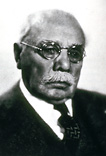 Ignaz Schwinn is best known for co-founding the Schwinn Bicycle Co., but he was also the owner of Excelsior Motorcycles in the United States (not to be confused with the British and German brand of the same name). Under Schwinn's direction, Chicago-based Excelsior became one of the world's leading motorcycle manufacturers of the 1910s and '20s. The company was heavily involved in racing and Excelsior riders earned numerous national championships and speed records.
Ignaz Schwinn is best known for co-founding the Schwinn Bicycle Co., but he was also the owner of Excelsior Motorcycles in the United States (not to be confused with the British and German brand of the same name). Under Schwinn's direction, Chicago-based Excelsior became one of the world's leading motorcycle manufacturers of the 1910s and '20s. The company was heavily involved in racing and Excelsior riders earned numerous national championships and speed records.
Schwinn was considered an innovator in cycle design. His original concepts and refinements of existing bicycle and motorcycle technology helped make both Schwinn Bicycles and Excelsior Motorcycles some of the most sought-after products in their field.
Schwinn was born in Hardheim, Germany, in 1860. When Schwinn was just 11 years old, his father died and the youngster was called on to help the family. Schwinn grew up poor and had little time for the frivolity that most youths enjoy. Instead, he took odd jobs where he could find them. At the age of 18, bicycle maker Heinrich Kleyer met the young Schwinn, who was working for one of the suppliers of Kleyer's bike manufacturer. Kleyer saw potential in Schwinn and hired him. Schwinn worked his way through the ranks, eventually becoming the designer and plant manager of the bicycle company.
The United States was the land of opportunity and Schwinn wanted to be a part of the rapidly growing U.S. bicycle market. He moved from Germany to Chicago in the spring of 1891. Once in the United States, Schwinn went right to work manufacturing high-quality bicycles. In 1895, he joined forces with Adolph Arnold, president of a local meat-packing house, to form Arnold, Schwinn & Co. With Arnold's business savvy and Schwinn's technical expertise, the company quickly flourished. In its first year, the company sold 25,000 bicycles. Schwinn bought out his partner in 1908.
While he had been busy advancing his bicycle business, Schwinn also found time to devote to purely experimental work. From 1897 to 1902, he manufactured 12 experimental automobiles and one motorized bicycle utilizing a De Dion engine. The ever-energetic Schwinn expanded his company when he bought the Chicago-based Excelsior Motorcycle Co. in 1911. Shortly after taking control of Excelsior, the company grew to become one of the "Big Three" U.S. motorcycle manufacturers, alongside Indian and Harley-Davidson. Schwinn continued expanding his company in the 1910s and purchased the Henderson Motorcycle Co. in 1917.
Schwinn saw the importance of racing to Excelsior's sales. The earliest Excelsior racing stars were Joe Wolters and Jake De Rosier (who came to Excelsior after a contentious break from Indian during the 1911 racing season). Wolters and De Rosier dominated much of the board track racing during 1911 and 1912. Carl Goudy was another top Excelsior rider of the period.
Perhaps the racer most closely associated with Excelsior was Bob Perry. Like Schwinn, Perry had lost his father in childhood, and Schwinn treated him like a son. Perry was the star of Excelsior's racing team from 1913 to World War I. When Perry died in January of 1920, Schwinn was distraught and temporarily pulled his company out of racing.
Joe Petrali was the last dirt track racing star for Excelsior, winning championships in the late 1920s. In Excelsior's final years, the company concentrated on national hillclimbing and riders like Gene Rhyne and Pete Uebelacker, as well as Petrali, continued to carry the Excelsior flag.
Schwinn reluctantly discontinued the manufacturing of motorcycles in 1931 due to the onset of the Depression. His bicycle division continued to be successful and he worked as active head of Schwinn until his death in 1948.